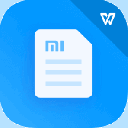


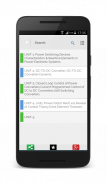
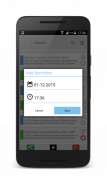
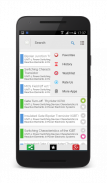
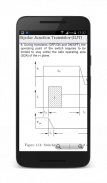

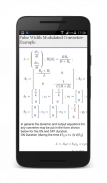
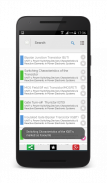
Electronics Switching

Mô tả của Electronics Switching
Electronics Switching is part of electronics and communications courses, the application covers 72 topics of Electronics Switching in detail. These 72 topics are divided in 5 units.
The app is a free handbook covering lecture notes, definitions, concepts, diagrams, formulas, theory, laws, tools, equations, calculations and graphs on the subject.
The App covers the topic in a flashcard like format, better than a book based learning, purpose of the App is faster learning and revisions of the subject.
Some of topics Covered in this application are:
1. Normalised Models of Switched Mode Power Converters
2. Dynamic Equations in pu
3. Visualisation of Functions
4. Some Common Functions as Dierential Equations
5. Strong and Weak Functions
6. Unity Power Factor Rectifiers
7. Power Circuit of UPF Rectifiers
8. Average Current Mode Control
9. Voltage Feedforward Controller
10. Resistor Emulator UPF Rectifiers
11. Non-linear Carrier Control
12. Single Phase and Polyphase Rectifier
13. Review of Control Theory
14. A Simple Linear Dynamic System
15. Laplace Transformation
16. Transfer Function
17. Physical Interpretation of the Transfer Function
18. Bode Plots
19. Concept of Double Injection and Extra Element Theorem
20. Introduction to DC-TO-DC Converter
21. Simple DC to DC Converter
22. Switched Mode Power Converters
23. More Versatile Power Converters
24. Discontinuous Mode of Operation in dc to dc Converters
25. Isolated dc to dc Converters
26. Introduction of DC-TO-DC Converter: Dynamics
27. Pulse Width Modulated Converter
28. Pulse Width Modulated Converter-Example
29. Averaged Model of the Converter
30. Circuit Averaged Model of the Converters
31. Generalised State Space Model of the Converter
32. Dynamic Model of Converters Operating in DCM
33. Closed Loop Control
34. Closed Loop Performance Functions
35. Effect of Input Filter on the Converter Performance
36. Design Criteria For Selection of Input Filter
37. Introduction to Current Programmed Control of DC to DC Converters
38. Sub-harmonic Instability in Current Programmed Control
39. Compensation to Overcome Sub-harmonic Instability
40. Determination of Duty Ratio for Current Programmed Control
41. Transfer Functions
42. Introduction of Soft Switching Converters
43. Resonant Load Converters
44. Steady State Modeling of Resonant SMPS
45. Resonant Switch Converters
46. Boost Converter with Zero Voltage Switching
47. Resonant Transition Phase Modulated Converters
48. Resonant Switching Converters with Active Clamp
49. Introduction of Power Switching Devices-Characteristics
50. Ideal Switches
51. Real Switches
52. Practical Power Switching Devices
53. Diodes
54. Thyristor or Silicon Controlled Rectifier (SCR)
55. Switching Characteristics of the SCR
56. Bipolar Junction Transistor (BJT)
57. Switching Characteristics of the Transistor
58. MOS Field Effect Transistor(MOSFET)
59. Gate Turn-off Thyristor (GTO)
60. Insulated Gate Bipolar Transistor (IGBT)
61. Switching Characteristics of the IGBT
62. Integrated Gate Commutated Thyristor (IGCT)
63. Thermal Design of Power Switching Devices
64. Intelligent Power Modules (IPM)
65. Introduction to Reactive Elements in Power Electronic Systems
66. Electromagnetics
67. Design of Inductor
68. Design of Transformer
69. Capacitors for Power Electronic Application
70. Types of Capacitors
71. Base Drive Circuits for BJT
72. Snubber Circuits for Power Switching Devices
IMPORTANT LINKS
Feedback: Share your feedback at essyengineering@gmail.com
Social links
Facebook : https://www.facebook.com/EngineeringEasy/
Twitter : https://twitter.com/easyengineerin
Website:http://www.engineeringapps.net/
</div> <div jsname="WJz9Hc" style="display:none">Điện tử chuyển mạch là một phần của thiết bị điện tử và truyền thông các khóa học, các ứng dụng bao gồm 72 chủ đề Điện tử Chuyển đổi chi tiết. Những 72 chủ đề được chia thành 5 đơn vị.
Ứng dụng là một cuốn sổ tay miễn phí bao gồm bài giảng, các định nghĩa, khái niệm, sơ đồ, công thức, lý thuyết, luật pháp, công cụ, phương trình, tính toán và đồ thị về đề tài này.
Các ứng dụng bao gồm các chủ đề trong một Flashcard như định dạng, tốt hơn so với một học tập cuốn sách dựa trên mục đích của ứng dụng là học nhanh hơn và các sửa đổi của chủ đề.
Một số chủ đề Bao trong ứng dụng này là:
1. Mô hình Normalised của Switched Mode Power Converters
2. Năng động, phương trình pu
3. Visualisation của các chức năng
4. Một số chức năng thông thường như Dierential phương trình
5. Chức năng mạnh mẽ và yếu
6. Thống nhất Yếu tố chỉnh lưu điện
7. Nguồn mạch của UPF bộ chỉnh lưu
8. Trung bình hiện tại Chế độ điều khiển
9. Điện áp điều khiển feedforward
10. Điện trở Emulator UPF bộ chỉnh lưu
11. phi tuyến Carrier kiểm soát
12. Giai đoạn đơn và Polyphase Rectifier
13. Xem xét các Lý thuyết điều khiển
14. Đơn giản Hệ thống tuyến tính động
15. Laplace chuyển đổi
Chức năng 16. Chuyển
17. Giải thích vật lý của các chức năng chuyển giao
18. Lô Bode
19. Khái niệm về tiêm đôi và thêm phần tử lý
20. Giới thiệu về DC-TO-DC Converter
21. DC đơn giản để chuyển đổi DC
22. Switched Mode Power Converters
23. linh hoạt hơn điện Converters
24. gián đoạn Chế độ hoạt động trong dc để dc Converters
25. dc Isolated để dc Converters
26. Giới thiệu về DC-TO-DC Converter: Dynamics
27. Độ rộng xung điều chế chuyển đổi
28. Độ rộng xung điều chế Chuyển đổi-Ví dụ
29. trung bình của người mẫu của chuyển đổi
30. mạch trung bình của người mẫu của Converters
31. Generalised Nhà nước không gian mẫu của chuyển đổi
32. Năng động Mô hình chuyển đổi Hoạt động trong DCM
33. Đóng cửa điều khiển vòng lặp
34. Chức năng Hiệu suất Closed Loop
35. Ảnh hưởng của Input Lọc trên Hiệu suất chuyển đổi
36. Tiêu chuẩn thiết kế Đối với lựa chọn của Input Lọc
37. Giới thiệu về hiện theo chương trình kiểm soát của DC để DC chuyển đổi
38. Tình hình bất ổn Sub-hài hòa trong hiện tại Programmed kiểm soát
39. Bồi thường để vượt qua bất ổn Sub-hài
40. Xác định Ratio Duty cho hiện tại Programmed kiểm soát
41. Chức năng chuyển
42. Giới thiệu về chuyển đổi chuyển mạch mềm
43. Converters tải cộng hưởng
44. Steady State mô hình hóa của Cộng hưởng SMPS
45. chuyển đổi Chuyển Resonant
46. Tăng Chuyển đổi với Zero Voltage Switching
47. Cộng hưởng chuyển tiếp giai đoạn điều chế Converters
48. chuyển đổi chuyển mạch cộng hưởng với Active kẹp
49. Giới thiệu về Power Switching Devices-Đặc điểm
50. Thiết bị chuyển mạch lý tưởng
51. Thiết bị chuyển mạch Bất
52. Thiết bị Power Switching thực
53. Điốt
54. Thyristor hoặc Silicon Controlled Rectifier (SCR)
55. Đặc điểm chuyển mạch của SCR
56. Bipolar Junction Transistor (BJT)
57. Đặc điểm chuyển mạch của Transistor
58. MOS Dòng Effect Transistor (MOSFET)
59. Cổng Turn-off Thyristor (GTO)
60. Insulated Gate Bipolar Transistor (IGBT)
61. Đặc điểm chuyển mạch của các IGBT
62. Tích hợp cổng đảo mạch Thyristor (IGCT)
63. Thiết kế tản nhiệt của thiết bị Power Switching
64. Các module điện thông minh (IPM)
65. Giới thiệu về phản ứng yếu tố trong hệ thống điện tử, điện
66. Electromagnetics
67. Thiết kế của Cuộn cảm
68. Thiết kế của Transformer
69. Tụ điện cho ứng dụng điện tử
70. Các loại tụ
71. Cơ sở Ổ Mạch cho BJT
72. Mạch Snubber cho các thiết bị chuyển mạch điện
LIÊN KẾT QUAN TRỌNG
Phản hồi: Chia sẻ thông tin phản hồi của bạn tại essyengineering@gmail.com
liên kết xã hội
Facebook: https://www.facebook.com/EngineeringEasy/
Twitter: https://twitter.com/easyengineerin
Website: http: //www.engineeringapps.net/</div> <div class="show-more-end">
















